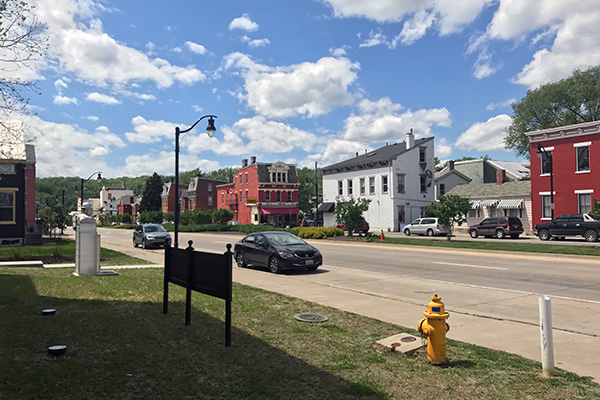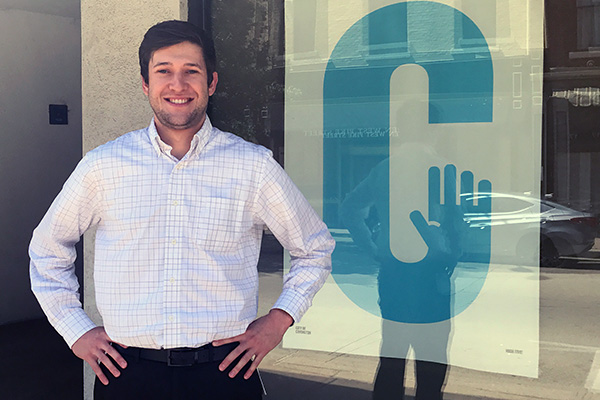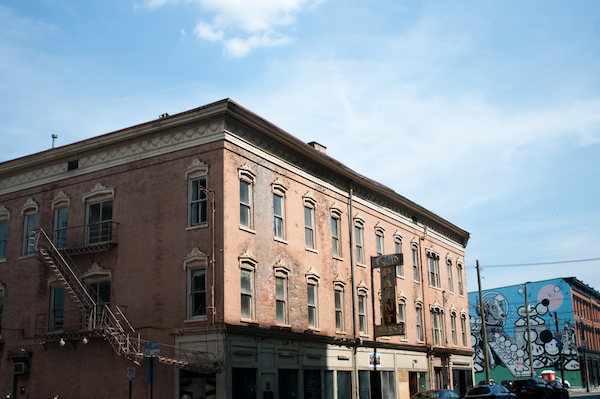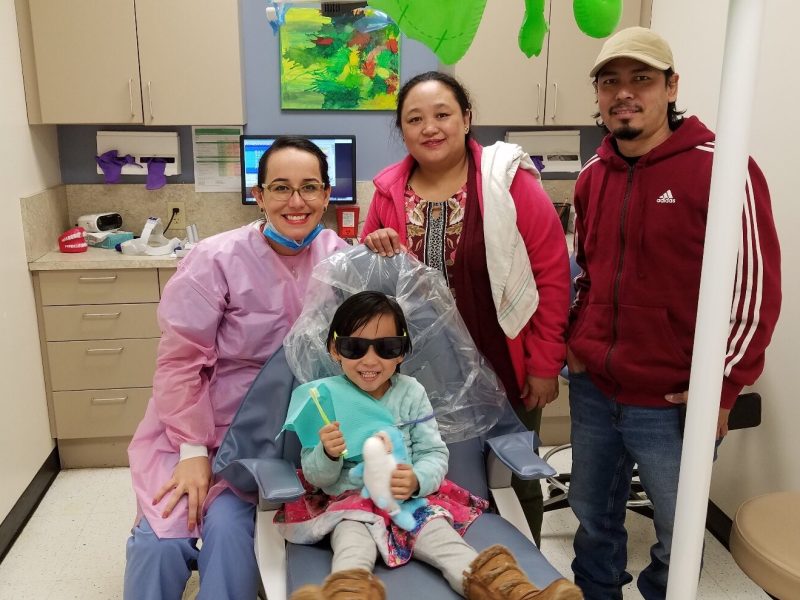Covington revives a commercial artery, one small business at a time
As the 12th Street/MLK corridor emerges as one of Covington's most important economic centers, thanks to renewed investment and fierce civic pride, On the Ground takes a look at the residents and leaders who hope to sustain the district's viability well into the future.
The Hellmann Creative Center at 321 W. 12th St. was once home to the Hellmann Lumber Mill. Now, the restored building houses community events space, artist studios and Covington’s Center for Great Neighborhoods.
But more than that, the space anchors what is becoming one of Covington’s most charming and diverse business districts.
Less than five years ago, the former lumber mill was just one of many vacant buildings along the 12th St./MLK corridor, a state route and key thoroughfare that spans multiple neighborhoods and connects neighboring Newport to I-75. A planned widening project was slow to come, so for years, private development had mostly stalled and business owners were hesitant to invest in the area.
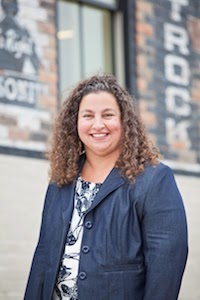
“Buildings were falling down, some had to be condemned and demolished,” says the Center’s Rachel Hastings, describing the long-lasting effects of that disinvestment on the community. “Crime here and in the surrounding area was really bad. Neighbors who had been here for a long time retreated to their houses.”
Once traffic and streetscape changes were completed in 2013, investing in the corridor was a logical move for the Center, which had already begun spurring other initiatives in the area. It began renovating the Hellmann Mill and solidified its commitment to the neighborhood by making it its permanent home last year.
But while the Hellmann building’s transformation is no doubt a crowning achievement to date, there’s still much work to be done, as the district inches toward viability and works to find its footing as one of Covington’s most important economic centers.
Serving up community by the cup
Aaron Galvin, owner of the Covington Coffee Company, arrived on 12th by way of Florida, but he has lived and traveled all over the world.
When he relocated to Northern Kentucky in 2012, he quickly fell in love with Covington — so much so that he convinced his parents to join him, relocating from upstate New York. Galvin lives in the Eastside neighborhood, in a multi-unit house that doubles as a rental investment property. He owns other properties, too, including a vacant lot that’s currently being used as an urban farm.
In many ways, Galvin is the quintessential Covington small business owner. Motivated by a love for his community and fellow residents, he is just as interested in driving economic and cultural viability as he is in making a living. His goal is to invest as much as he can back into the neighborhood.
“There are a lot of small businesses investing in Covington and, with that, it will maintain its character,” he says.
Opening Covington Coffee was a bit of a sidestep for Galvin professionally. The idea was inspired by his experience of living in New Orleans after Hurricane Katrina. There, he witnessed a community coming together in a time of crisis and how places like the local coffee shop became ground zero for residents moving forward together.
When he moved to Covington, Galvin noticed a void in those types of family-friendly gathering places that are open later in the day and designed to build personal connections. So, he took the leap and opened the shop.
But crisis soon struck when Galvin and a customer were robbed at gunpoint in the shop. Then, a few months later, Galvin received notice that the building he was leasing had been sold and he would need to close up shop or relocate.
Afraid of losing momentum, he reached out to friends and neighbors for help keeping the business alive.
Betting on small business for big development

Galvin first sought help from the Center in securing a new location. They came through, selling him a vacant property just a few blocks away from his current spot — at a price he couldn’t pass up.
As is the case with many vacant, historic properties, Galvin’s new building — which is set to open this fall — will require extensive exterior work, as well as interior renovations and finishing. The Center provided some grant funding toward the exterior improvements, as did another partner: the City of Covington.
The City of Covington’s Small Business Program provides major incentives for new business owners, including help with upper-floor renovation and façade improvement. It also provides rent subsidies for brand-new businesses that are not yet ready to purchase a property.
Ross Patten oversees the city’s small business incentives and works to attract and support new Covington businesses. He sees that support as a great way to invest in the future of Covington.
“From a city standpoint, we get a new business that’s creating foot traffic on the street,” he says. “And we’re helping out a new business, which sets them off on a good foundation to create more jobs and expand from there.”
In addition to the Small Business Program, the city has created a comprehensive Covington Business Guide to help with everything from securing necessary permits to meeting appropriate historic preservation guidelines to ordering curbside garbage pickup. The city also helps with promoting new businesses and pairing their concepts with available real estate.
With help from The Center and the City of Covington, Galvin is moving forward with renovations for his new building. He has tapped local architects and contractors to develop the site and plans to fund the rest of the renovations himself.
“A lot of people don’t start a business because they think they don’t have the money to do it; and in most places in the world, that might be true,” Galvin says. “But in Covington right now, if you wanted to do something like start your own bakery, someone will want to support you — or sell you an oven, or tell you about their grandmother’s cookies. That’s what makes me so optimistic about starting a business here.”
Covington fabric getting stronger by the day
Neither Galvin nor the 12th Street business district are alone in making small investments toward Covington’s future — and some investments aren’t so small.
In areas like the Central Business District, Mainstrasse Village and the Pike Street corridor, private investors are taking chances with the small- and large-scale mixed-use and commercial developments that are popping up all over town.
While some business owners and developers have the means to fund their own projects, others need more specialized support. To that end, the Catalytic Fund leverages a $10 million investment fund to issue project-specific grants and professional management services that help make complex projects come to life.
Catalytic Fund-driven partnerships have been instrumental in bringing about highly visible renovations along Madison Avenue, such as the Northern Kentucky Career Center, Hotel Covington and ongoing renovations to the historic Mutual Building.
Those groups are planning another historic renovation of the Bradford Building at Fourth Street and Scott Boulevard, a project that will result in a number of upscale condos and street-level commercial space.
By design, both large developers and small business owners have a place in Covington’s economic development picture. This supportive climate is drawing investment from many different sectors: hospitality, dining, social service and even light manufacturing.
For its part, The Center has a soft spot for creative types.
The property Galvin purchased for his coffee shop was part of The Center’s Homes for Makers program, which pairs local creative entrepreneurs with live/work properties that are in need of a little extra love.
Hastings says Homes for Makers is designed “to encourage homeownership and small business entrepreneurs and encourage families to build equity in their homes so that they can be a stakeholder as property values increase over time in the neighborhood.”
This spirit of innovation and support makes it easier to assess the community’s needs from the ground level up. It’s what attracted Galvin, and he says the ability to live in the neighborhood, walk to work and get to know his neighbors makes him a better business owner.
A focus on people is a major part of Covington’s renewed focus, one that believes that creative entrepreneurs and small business owners, when given a chance, will play a big part in building a diverse economy that caters to its residents.
That’s the big picture that Galvin and other Covington entrepreneurs envision.
“I’ve lived in apartments in other places where I wouldn’t paint the walls because they weren’t my walls,” Galvin says. “But now this is my town. I’d like to put a fresh coat of paint on it.”
The Northern Kentucky Fund of the Greater Cincinnati Foundation is proud to underwrite Soapbox’s On the Ground: Covington series. The Northern Kentucky Fund believes that highlighting the successes and challenges in our community fosters effective dialog and action, creating communities where everyone can thrive. Other On the Ground partners include The Center for Great Neighborhoods, which is working collaboratively toward community transformation with series sponsor Place Matters partners LISC and United Way of Greater Cincinnati. Data and analysis is provided by The Economics Center.

